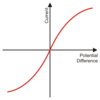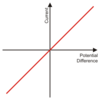Combined Physics - P2 Electricity Flashcards
What is the circuit symbol for an open switch?

What is the circuit symbol for a closed switch?

What is the circuit symbol for a cell?

What is the circuit symbol for a battery?

What is the circuit symbol for a diode?

What is the circuit symbol for a resistor?

What is the circuit symbol for a variable resistor?

What is the circuit symbol for an LED?

What is the circuit symbol for a lamp?

What is the circuit symbol for a fuse?

What is the circuit symbol for a voltmeter?

What is the circuit symbol for an ammeter?

What is the circuit symbol for a thermistor?

What is the circuit symbol for an LDR?

What is current?
The rate of flow of charge
What equation links charge flow, current and time?
Charge flow = current x time
Q = I t
Describe the IV graph for a resistor at constant temperature.

- Current is directly proportional to potential difference.
- Resistance is constant.
What type of circuit is shown in the image?

Series circuit
Explain the shape of the IV graph for a diode.

- Current only flows in one direction through a diode.
- There is high resistance in the opposite direction meaning current doesn’t flow.
What equation links potential difference, current and resistance?
Potential difference = current x resistance
V = I R
What type of circuit is shown in the image?

Parallel circuit
Draw an I-V graph for a filament lamp.

For a given potential difference, what happens to the current when the resistance increases?
The current decreases.
Explain the shape of the IV graph for a filament lamp.

As the current increases the temperature of the filament lamp increases (so the resistance increases) meaning less current can flow per unit potential difference.
Draw an I-V graph for an ohmic resistor (e.g. a resistor at a constant temperature).

Draw an I-V graph for a diode.












